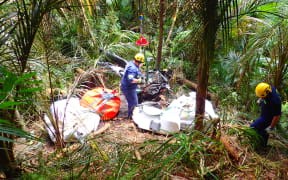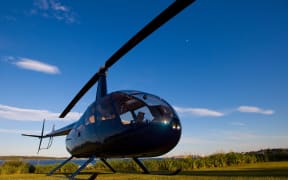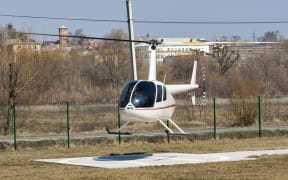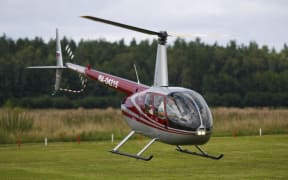An interim report into the fatal crash of a Robinson R44 helicopter in Northland in October has found it is "very unlikely" mast bumping caused the accident.

Investigators remove the wreckage of a Robinson R44 helicopter in Glenbervie forest near Whangarei. Photo: Supplied / Transport Accident Investigation Commission
Allan Jessop, 42, from Tangiteroria, and Derek Hammond, 49, from Kauri, died when their helicopter crashed in Glenbervie Forest, north of Whangarei, on 31 October.
The two men had been on a short survey flight ahead of a forestry spraying run when the accident occurred.
The helicopter crashed into dense native forest about 1pm and the men's bodies were discovered in the burnt-out wreckage a short time later.
Robinson helicopter models have been linked to a problem known as mast bumping and, on 27 October, the Transport Accident Investigation Commission (TAIC) had added this type of occurrence to its watchlist of pressing transport safety concerns.
Mast bumping is when the inboard end of a main rotor blade (the spindle) contacts the main rotor driveshaft (or mast).
It can result in the main rotor blades striking the helicopter's cabin, causing it to break up in-flight.
TAIC's interim report into the Glenbervie Forest crash said the spread of wreckage meant it was highly unlikely mast bumping was behind the crash.
"The confined nature of the wreckage field, and the type of damage found on the main rotor blades and the tail boom, suggested that it was very unlikely that the helicopter had broken up in-flight or that the accident had been caused by mast bumping."
In a statement, the Robinson Helicopter Company thanked the commission for its thorough and prompt investigation.
It blamed the New Zealand aviation environment for earlier accidents involving its helicopters.
"Regarding previous New Zealand accidents, which involved low-G mast bumping, these appear to stem from certain training, operational culture and regulatory elements unique to New Zealand."
The company applauded the Civil Aviation Authority for seeking to improve the level and consistency of training and said it supported the authority's work.
The statement also pointed out that the large number of Robinson helicopters operating in New Zealand contributed significantly to the economy and to the provision of support services.
"For example, in the recent earthquakes, Robinson operators were the first responders using their helicopters to assist in rescue operations."
The company said TAIC's watchlist - and the Department of Conservation suspension on the use of its helicopters - was having a negative effect on operators, their businesses and the economy.
"The improved training and operational procedures being implemented will increase safety and should allow normal helicopter operations to resume."
The commission is now investigating further lines of inquiry for October's crash, including but not limited to:
- The procedures for the conduct of forestry aerial spraying operations
- The condition of the engine before the accident
- The pre-impact integrity of the main rotor control system
- Weather conditions at the time of the accident
- The maintenance history of the helicopter and its engine
Helisika is the license-holder for Helinorth, the small Northland operator that flew the Robinson that crashed.
Shortly after the crash, Helisika chief pilot Greg Gribble said the Robinson R44 was only a couple of years old and had only about 600 to 700 flying hours on the clock.
He said the helicopter was well-maintained at Helisika's Ardmore base.
According to TAIC, there have been five deaths involving a Robinson R44 since 1991.
Over the same period, there have been 14 deaths in accidents involving Robinson R22s and one involving the R66 - a total of 20 deaths.
The approximately 300 registered Robinson helicopters made up about 40 percent of the country's helicopters, the TAIC said.





